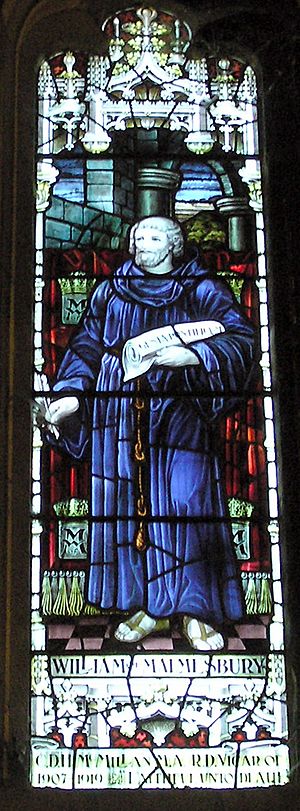William of Malmesbury facts for kids
William of Malmesbury (born around 1095, died around 1143) was a very important English historian from the 12th century. Many people think he was one of the best English historians after Bede, another famous historian. One modern historian, C. Warren Hollister, called William "a gifted historical scholar." This means William was a very talented history expert who loved to read. He knew a lot about ancient history, early Christian writings, and even books from his own time. Some even say he might have been the most learned person in Western Europe during the 1100s!
William was born in Wiltshire, England, around 1095 or 1096. His father was Norman, and his mother was English. He lived his whole life in England. As an adult, he became a monk at Malmesbury Abbey in Wiltshire. Monks are men who dedicate their lives to religious service and often live in a community called an abbey.
Contents
William's Life and Learning
William received his education at Malmesbury Abbey. He learned a bit about logic (how to reason) and physics (how the world works). But he spent most of his time studying moral philosophy (right and wrong) and history.
One of the first things he did was help Abbot Godfrey, the head of the abbey, build a large library. This library was for everyone in the community to use. William had direct knowledge of at least 400 books by over 200 different authors!
As he studied, he collected many medieval history books. This inspired him to write his own popular history of England. He wanted it to be like the Ecclesiastical History of the English People written by Bede. William greatly admired Bede, and you can see this in the introduction to his own book, Gesta Regum Anglorum.
His Main Books
In 1125, William finished his book called Gesta Regum Anglorum, which means "Deeds of the English Kings." This book covered English history from the year 449 to 1120. He later updated and added to it, bringing the history up to the year 1127. This updated version is now seen as one of the greatest histories of England.
After his first history book, William wrote Gesta Pontificum Anglorum in 1125. This book means "Deeds of the English Bishops." It was a lively history of abbeys and bishoprics (areas led by bishops). It focused on the lives of important English church leaders and saints. To write this book, William traveled widely across England.
He even stayed for a while at Glastonbury Abbey. There, he wrote a book called On the Antiquity of the Glastonbury Church for his friend, Abbot Henry of Blois.
Later Life and Importance
Around 1139, William became friends with Roger, Bishop of Salisbury. Bishop Roger controlled Malmesbury Castle, which was a helpful local connection. Because William's book Gesta Regum was so well-received, he was offered the job of abbot of Malmesbury in 1140. However, William turned down the offer. He preferred to continue his work as a librarian and scholar.
William made one public appearance at a meeting in Winchester in 1141. At this meeting, the church leaders supported Empress Maud (also known as Empress Matilda) in her fight for the throne.
Around 1140, William continued his historical writings with the Historia Novella, or "modern history." This book had three parts and covered events from 1128 to 1142. It included important details about the time of trouble known as "the Anarchy" during King Stephen's reign. This book ends with a promise that he would continue it, but William likely died before he could. William also wrote a history of his own abbey and several stories about saints' lives.
Why William Was Important
Many people, including the famous writer John Milton, believe William was one of the best English historians of his time. He is still known for his strong research and his clear, interesting writing style. He wrote well in Latin and had excellent skills for writing history.
His work is very valuable for understanding the period after 1066. You can find many interesting stories and smart opinions about people and events in his books. Some experts point out that his timeline can be a bit confusing, and his organization of material sometimes seems careless. However, William's works are still considered very important. Despite any small issues, he remains one of the most celebrated English historians of the 12th century.
William also wrote about religious communities, especially those of Benedictine nuns like Shaftesbury, Nunnaminster, and Wilton. His writings give us a look into the lives of nuns in England during the Middle Ages. He observed how they followed their leaders, cared for holy relics, and prayed for others. His travels also allowed him to compare different communities. He was clearly impressed by the women's monasteries he visited. One scholar, Katie Ann-Marie Bugyis, noted that William felt their holiness and dedication were equal to, or even better than, those of male monks.
Images for kids
-
Malmesbury Abbey in Wiltshire, completed in 1180. It is still used today as a church.



